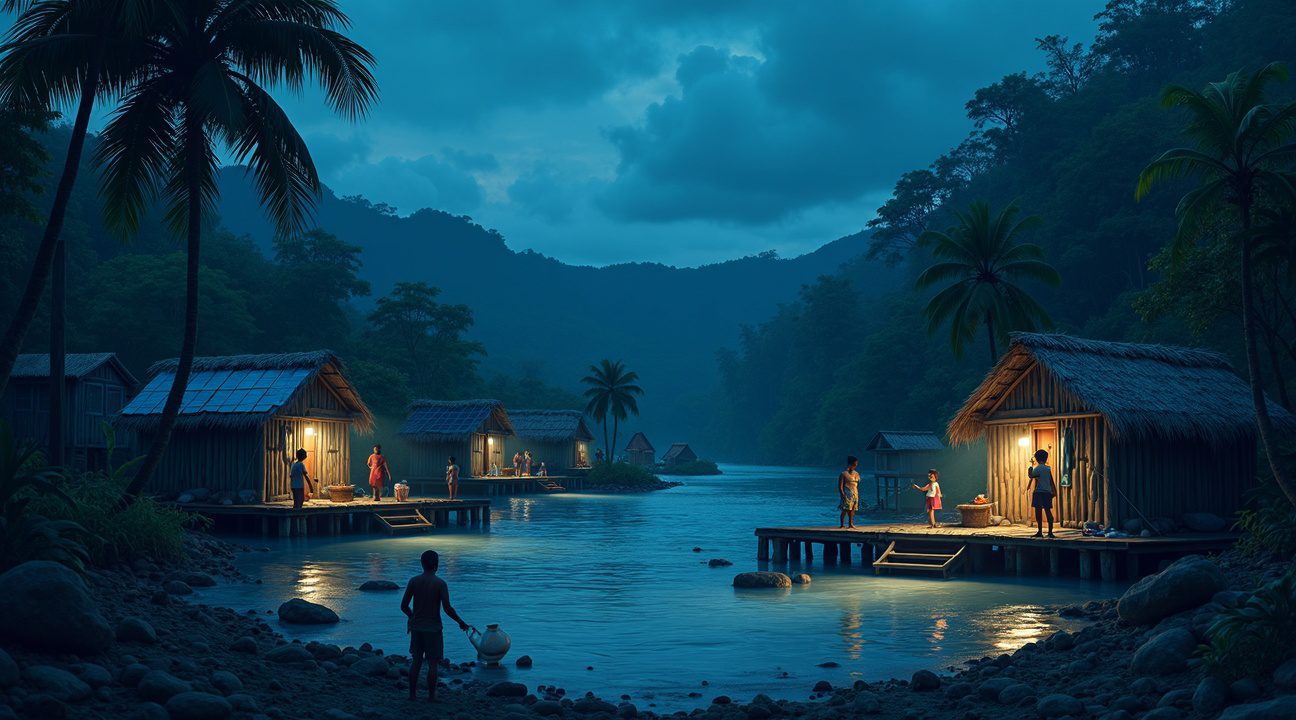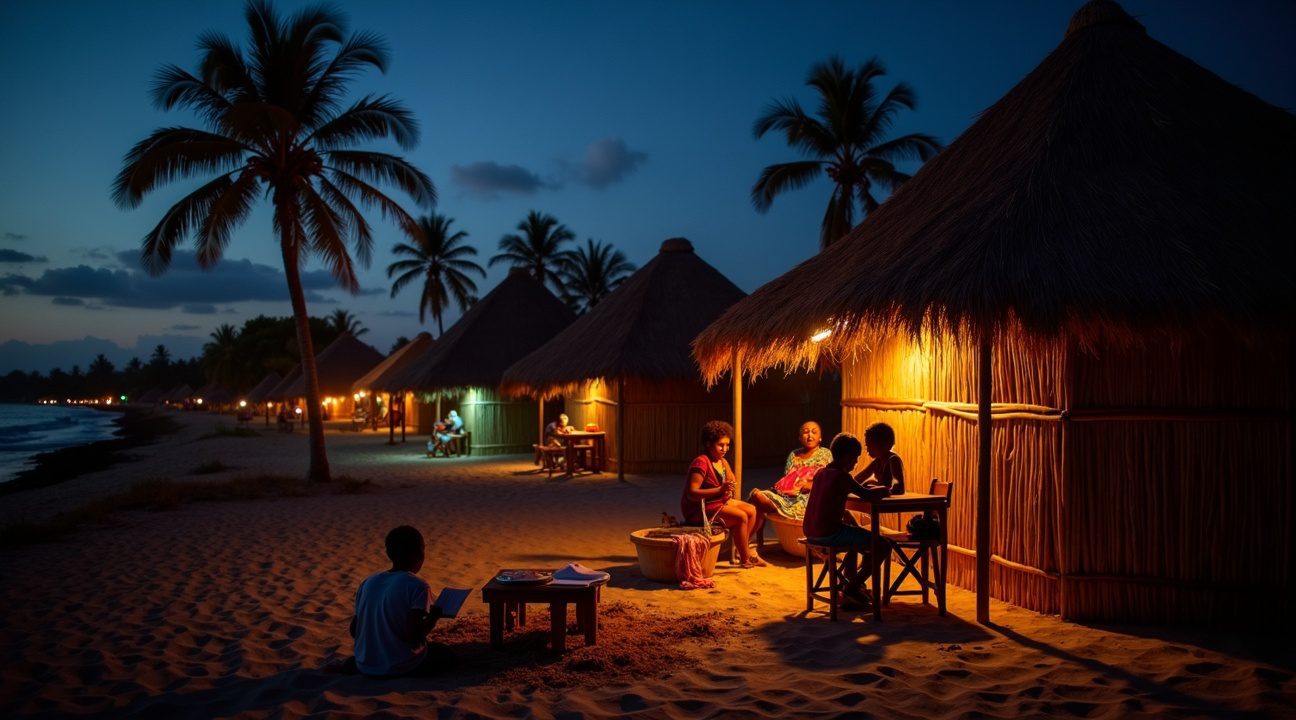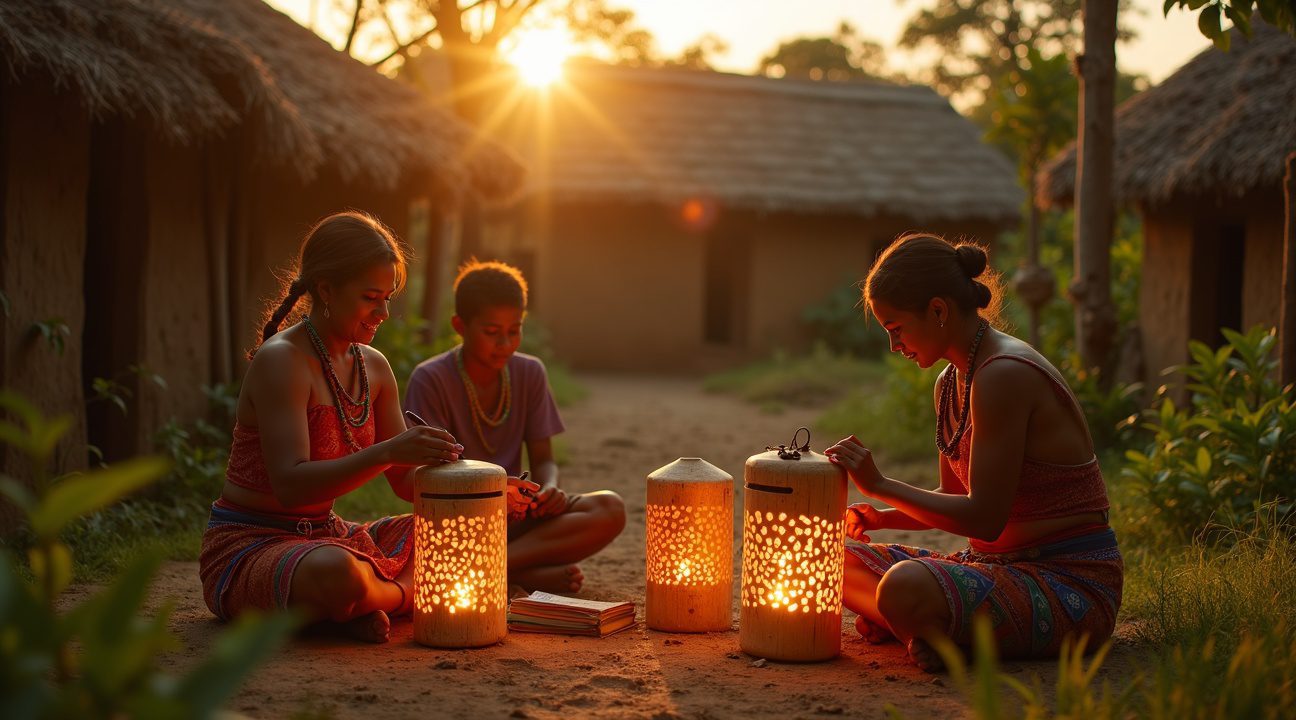Colombian villages have gained access to sustainable electricity through WaterLight, an innovative device that transforms just 500ml of saltwater into 45 days of continuous power.
Key Takeaways
- WaterLight converts saltwater into electricity through ionization, creating a reaction between electrolytes and specialized magnesium and copper plates that powers LED lights and charges devices for up to 45 days per refill.
- The device offers significant advantages over solar alternatives by providing weather-independent power generation, immediate restart capability with saltwater refills, and consistent output regardless of sunlight conditions.
- Wayuu villages in Colombia’s La Guajira peninsula have experienced transformative improvements in education, fishing activities, and artisan work as children can study after dark and adults can extend productive hours.
- Each WaterLight unit incorporates traditional Kanas weaving by local craftswomen and uses sustainable Urapan wood, creating economic opportunities while respecting cultural heritage and costing between $60–$100.
- Global expansion plans target coastal communities in Sierra Leone, Somalia, and Syria, focusing on regions with abundant seawater but limited electrical infrastructure to address energy poverty affecting 840 million people worldwide.
How WaterLight Technology Works
The WaterLight device operates through a simple yet ingenious ionization process. Salt ions from seawater react with specialized internal plates made from magnesium and copper. This chemical reaction generates electrical current that powers bright LED lights and provides USB charging ports for mobile devices. Users simply pour 500ml of seawater into the device to activate power generation immediately.
Performance and Efficiency
Technical specifications demonstrate impressive efficiency ratings. Each refill delivers 45 days of continuous operation with consistent brightness levels. The device produces enough power to charge smartphones multiple times while maintaining steady illumination throughout its operational cycle. Internal components resist corrosion through advanced materials engineering that extends device lifespan significantly.
Weather-Independent Energy
Weather conditions don’t affect WaterLight performance unlike solar panels that depend on sunlight availability. Coastal storms, cloudy days, and monsoon seasons no longer interrupt power generation. Communities gain reliable electricity access regardless of environmental factors that traditionally limit renewable energy solutions in remote locations.
Real-Life Impact in Colombia
Transforming Daily Life in Wayuu Communities
Field testing in Wayuu villages revealed dramatic improvements in daily life quality. Children now complete homework assignments after sunset using bright LED illumination. Fishermen prepare equipment and mend nets during evening hours previously spent in darkness. Artisan women extend weaving sessions to increase income from traditional crafts sold in regional markets.
Strengthening Economic Opportunities
Economic benefits extend beyond individual households to entire community structures. Local craftswomen earn steady income by incorporating traditional Kanas weaving patterns into each WaterLight unit’s exterior design. This collaboration preserves cultural heritage while creating sustainable employment opportunities that strengthen village economies.
Environmentally Responsible Materials
Manufacturing emphasizes environmental responsibility through sustainable material selection. Urapan wood provides renewable casing materials harvested from responsibly managed forests. Internal components use recyclable metals that minimize environmental impact during production and eventual disposal phases.
Cost and Affordability
Cost analysis shows favorable economics compared to alternative energy solutions. Each WaterLight unit retails between $60–$100, making it accessible for coastal communities with limited financial resources. Operating costs remain minimal since seawater serves as free fuel throughout the device’s operational lifetime.
Durability and Maintenance
Durability testing confirms long-term reliability under harsh coastal conditions. Salt spray, humidity, and temperature fluctuations don’t compromise device performance. Simple maintenance requirements allow users to clean and refill units without technical expertise or specialized tools.
Improving Critical Community Services
Educational Benefits
Educational impacts prove particularly significant for isolated communities lacking grid electricity access. Students extend study hours well past sunset using bright, consistent lighting that reduces eye strain. Literacy rates improve as children spend additional time reading and completing assignments previously impossible in darkness.
Healthcare Applications
Healthcare applications emerge as communities use WaterLight devices in medical facilities. Rural clinics extend operating hours for patient care and emergency treatments. Refrigeration of essential medications becomes possible through consistent power generation that maintains cold storage requirements.
Enhanced Communication
Communication capabilities expand as villagers charge mobile phones reliably. Emergency contact with urban areas becomes possible during storms and medical crises. Business connections improve as artisans coordinate product sales and material purchases through mobile communication networks.
Global Expansion Outlook
Target Regions
- Sierra Leone: Coastal areas offer abundant seawater but lack electrical infrastructure. WaterLight could provide a cost-effective, sustainable solution to energy poverty.
- Syria: Conflict-impacted communities face limited access to regular power. WaterLight’s independence from state infrastructure offers a reliable alternative.
- Somalia: Fishing villages present ideal deployment opportunities where traditional energy sources face logistical and economic obstacles.
Scaling and Distribution
Scaling production requires partnerships with local manufacturers and distribution networks. Regional assembly facilities could reduce transportation costs while creating employment opportunities in target markets. Training programs would develop technical support capabilities for device maintenance and user education.
Impact Measurement and Future Innovations
Impact measurement focuses on quantifiable improvements in education, healthcare, and economic outcomes. Student performance metrics track academic progress enabled by extended study hours. Health indicators monitor improved medical care delivery in electrified clinics.
Future development plans include enhanced power output models and additional charging capabilities. USB-C integration would support modern device charging requirements. Solar hybrid versions could combine ionization and photovoltaic technologies for maximum power generation efficiency.
Conclusion
The WaterLight initiative demonstrates how innovative engineering can address fundamental human needs through accessible technology. Simple operation requirements enable widespread adoption without extensive training programs. Cultural integration shows respect for local traditions while delivering modern benefits to underserved populations.
Research continues into optimizing electrolyte reactions and extending operational periods per refill. Advanced materials could increase power output while maintaining cost-effectiveness for target markets. Partnerships with international development organizations could accelerate global deployment efforts.
Meet the WaterLight: A Portable Lantern That Transforms 500ml of Saltwater into 45 Days of Electricity
I’ve discovered a revolutionary device that’s changing how remote Colombian villages access electricity. The WaterLight represents a breakthrough in portable renewable technology, developed through a collaboration between Colombian renewable energy start-up E-Dina and Wunderman Thompson Colombia. This innovative saltwater lamp converts just 500 ml of seawater into an impressive 45 days of continuous illumination.
How the WaterLight Works
The device operates through a fascinating ionization process that generates electricity from simple saltwater. Electrolytes present in the saltwater react with specialized magnesium and copper plates inside the unit, creating a reliable electrical current. This reaction powers the LED lights and simultaneously charges a small internal battery system.
Unlike solar alternatives that require consistent sunlight exposure, this portable renewable device functions regardless of weather conditions or time of day. The ionization process continues as long as the saltwater remains in contact with the metal plates, making it particularly valuable for communities in areas with limited sun exposure or during extended rainy seasons.
Beyond basic lighting, the WaterLight serves as a mini power generator equipped with a USB port for charging small electronics. Residents can power mobile phones, radios, and other essential devices, connecting isolated communities to communication networks and emergency services.
The engineering brilliance extends to emergency scenarios where seawater isn’t available. The device can operate using urine as an alternative electrolyte source, providing critical lighting and power during natural disasters or extreme circumstances. This versatility makes it an invaluable tool for disaster preparedness and humanitarian aid efforts.
Durability stands as another key advantage of this saltwater-powered innovation. Each WaterLight unit offers approximately 5,600 hours of operation, equivalent to two or three years of typical household use. The refillable and reusable design eliminates the need for battery replacements or complex maintenance procedures.
I find the environmental impact particularly compelling. Traditional kerosene lamps and diesel generators commonly used in off-grid areas produce harmful emissions and require costly fuel supplies. The WaterLight eliminates these concerns while providing consistent, clean energy from an abundant natural resource.
Installation requires no technical expertise. Users simply add saltwater to the designated chamber, and the ionization begins immediately. The device starts producing light within seconds, making it accessible to all age groups and skill levels.
The implications for Colombian coastal villages are substantial. Communities previously dependent on expensive and polluting fuel sources now have access to sustainable lighting and communication capabilities. This technology represents more than just illumination – it provides educational opportunities for children to study after dark and enables adults to engage in productive evening activities.
How the Technology Works and Compares to Solar Alternatives
WaterLight harnesses a well-established scientific principle—electrolysis in salty water using metal electrodes—but achieves sustained performance through innovative custom circuitry that maintains chemical reactions over extended periods. This approach is particularly fascinating because it transforms something as simple as saltwater into a reliable power source. The device can extract up to 500 watts per liter of water under optimal conditions, making it a surprisingly powerful energy solution for communities that have long struggled with electricity access.
The electrolysis process works by creating an electrical reaction between the saltwater and specialized metal electrodes within the device. What sets WaterLight apart from traditional electrolysis applications isn’t the basic science—it’s the engineering that allows this reaction to continue producing electricity for extended periods without degradation. This sustained performance comes from carefully designed circuitry that manages the chemical process efficiently, preventing the rapid deterioration that typically limits similar devices.
Advantages Over Solar Power Solutions
When comparing WaterLight to solar-powered alternatives, several key advantages emerge that make it particularly valuable for remote Colombian villages. Solar power systems face significant limitations in regions with unpredictable weather patterns, cloudy seasons, or dense forest canopies that block sunlight. WaterLight provides on-demand, weather-independent electricity generation that doesn’t rely on favorable atmospheric conditions to function effectively.
The operational reliability of WaterLight extends beyond weather independence. Solar lamps and panels require specific maintenance schedules, battery replacements, and optimal positioning to maintain efficiency. In contrast, WaterLight begins regenerating electricity immediately after being refilled with saltwater, offering a more straightforward maintenance approach for communities without technical expertise. This simplicity proves crucial in remote areas where repair services and replacement parts remain difficult to access.
Another significant advantage lies in the predictable power output:
- Solar installations experience daily cycles of energy production and storage, with efficiency dropping during shorter winter days or extended cloudy periods.
- WaterLight delivers consistent electricity generation as long as saltwater remains available, providing communities with more reliable planning capabilities for their energy needs.
The longevity factor also favors WaterLight technology:
- Solar panels typically require battery replacements every few years, and the panels themselves degrade over time due to weather exposure.
- WaterLight devices maintain their effectiveness longer because they don’t depend on photovoltaic cells that deteriorate from UV exposure or batteries that lose capacity through repeated charge cycles.
WaterLight addresses a critical global challenge, as the World Health Organization reports that 840 million people still live without electricity access worldwide. This statistic highlights the urgent need for renewable energy solutions that work reliably in diverse geographical and climatic conditions. Traditional grid expansion remains economically unfeasible for many remote communities, making innovative approaches like WaterLight essential for bridging the energy gap.
The technology represents part of a larger movement focused on providing dependable electricity access to underserved populations. Unlike solar alternatives that require significant upfront investment and ongoing maintenance infrastructure, WaterLight offers a more accessible entry point for communities with limited resources. The device’s ability to function with locally available saltwater eliminates supply chain dependencies that often complicate solar installations in remote locations.
For Colombian coastal villages, the abundance of seawater makes WaterLight particularly practical. These communities can maintain their power supply without relying on external suppliers or complex distribution networks. The technology transforms a readily available local resource into electricity, creating energy independence that solar solutions can’t match in areas with unreliable sun exposure.
The immediate regeneration capability sets WaterLight apart from battery-dependent alternatives:
- When solar systems fail during critical periods—such as medical emergencies or severe weather events—communities face dangerous power outages.
- WaterLight’s ability to restart electricity generation simply by adding saltwater provides a crucial backup capability that enhances community resilience and safety.
Learn more about WaterLight’s functionality in this demonstration:
https://www.youtube.com/watch?v=WZM_t5HcYPY

Transforming Lives in Wayuu Villages: From Darkness to Opportunity
I’ve witnessed how the introduction of WaterLight technology has fundamentally changed daily routines in Wayuu villages across Colombia’s La Guajira peninsula. Children now extend their study hours well beyond sunset, while local artisans can continue crafting traditional goods during evening hours. Fishers have gained the unprecedented ability to work during nighttime, opening new opportunities for their livelihoods that were previously impossible without reliable lighting.
Breaking the Cycle of Energy Poverty
Limited access to electricity severely impacts indigenous and rural communities throughout northern Colombia, with the Wayuu people facing particularly challenging circumstances. The La Guajira region represents just one part of a global crisis where up to 840 million people still lack access to reliable power sources. This energy poverty creates barriers to education, economic development, and basic quality of life improvements.
The coastal geography of La Guajira provided an unexpected advantage in addressing these challenges. The abundance of seawater along the peninsula inspired engineers to develop a solution that transforms this readily available resource into electrical power. Unlike traditional energy infrastructure that requires extensive investment and maintenance, this saltwater-based technology leverages what’s already abundant in coastal communities.
Daily life improvements extend far beyond basic lighting needs:
- Students can now complete homework assignments after dark, fundamentally changing educational outcomes in these remote villages.
- Community development initiatives have shown how access to light directly correlates with improved learning and economic opportunities.
Community-Centered Innovation
The development process prioritized collaboration with the Wayuu community from the project’s inception. Engineers didn’t simply impose external solutions but instead worked closely with community leaders to understand specific cultural needs and daily challenges. This approach ensured that technological innovations aligned with traditional practices and social structures.
Cultural identity played a crucial role in shaping both the technology’s design and implementation strategy. The Wayuu people’s deep connection to their coastal environment made saltwater-powered devices particularly appealing, as they could maintain energy independence using local resources. Traditional fishing practices could now extend into evening hours, allowing families to increase their catch and improve food security.
Rural electrification efforts in indigenous Colombia often fail because they don’t account for community-specific requirements. The WaterLight project succeeded by recognizing that sustainable solutions must respect cultural values while addressing practical needs. Community members became active participants in the technology’s refinement rather than passive recipients of external aid.
Artisans who previously stopped working at sunset can now continue producing traditional crafts during evening hours. This extension of productive time has:
- Created new income opportunities
- Helped preserve cultural practices that might otherwise face challenges from modern economic pressures
The technology’s simplicity means community members can operate and maintain the devices without extensive technical training.
The collaborative approach has created a model for how energy solutions can be developed with indigenous communities rather than for them. Local feedback shaped device durability requirements, user interface design, and maintenance procedures. This partnership approach ensures long-term sustainability while empowering communities to take ownership of their energy future.
Fishing activities have particularly benefited from nighttime lighting capabilities. Families can now:
- Plan fishing expeditions during optimal conditions
- Experience improved catch rates
- Gain more consistent income sources for coastal communities
The success in La Guajira demonstrates how accessible technology can address energy poverty while respecting cultural autonomy. Rather than waiting for grid infrastructure that may never reach remote villages, communities can now generate their own electricity using resources that surround them daily.
https://www.youtube.com/watch?v=aHbZY_FgFas

Built for Communities: Sustainable Design Using Local Materials and Craftsmanship
WaterLight represents more than innovative technology—it embodies a commitment to community-centered design that honors local traditions while addressing pressing energy needs. The device is crafted from recycled and locally available Urapan wood, ensuring that materials are both sustainable and accessible to the communities that need them most. This approach reduces environmental impact while supporting local economies and traditional practices.
Community Integration Through Traditional Craftsmanship
The most striking aspect of WaterLight’s design lies in its incorporation of Wayuu artisan craft known as Kanas weaving. Local craftswomen apply these decorative patterns to each device, creating a beautiful fusion of modern technology and ancestral traditions. This collaboration provides economic opportunities for women in these communities while ensuring that each unit reflects the cultural identity of its users. The Kanas weaving doesn’t just serve an aesthetic purpose—it strengthens community ownership and pride in the technology.
Practical Design for Real-World Conditions
Engineers designed WaterLight to withstand the challenging conditions found in rural Colombian communities. The waterproof construction protects internal components from moisture and rain, while the robust build quality ensures reliable operation in various environmental conditions. Beyond its primary function, the device offers additional practical benefits that enhance its value to users. After generating electricity, the saltwater can be repurposed for cleaning or washing, eliminating waste and providing extra utility.
Performance specifications make WaterLight particularly attractive for remote communities:
- A single refill delivers up to 45 days of continuous output.
- Provides consistent lighting and power for essential needs.
- Total lifespan reaches 5,600 hours, offering years of reliable service.
Cost considerations remain crucial for widespread adoption in underserved communities. During early production stages, each unit costs between $60 and $100, positioning it as an affordable alternative to traditional energy solutions. This price point makes the technology accessible while accounting for the quality materials and skilled craftsmanship involved in production.
The emphasis on recyclable materials extends beyond the Urapan wood components. Every aspect of WaterLight’s construction considers end-of-life disposal and environmental impact. This holistic approach to sustainability ensures that communities aren’t simply trading one environmental challenge for another.
Local craftsmanship integration proves that sustainable product design can simultaneously preserve cultural heritage and drive technological innovation. By engaging traditional artisans in the manufacturing process, WaterLight creates a model that other sustainable technologies might follow. This approach demonstrates how modern solutions can respect and strengthen existing community structures rather than disrupting them.
To learn more about WaterLight, you can visit the official WaterLight website.
https://www.youtube.com/watch?v=QKrfleA8nT4

Global Expansion Plans: Bringing Saltwater Power to Coastal Communities Worldwide
WaterLight’s creators engineered the device with global scalability at its core, making it accessible to NGOs, governments, and private buyers who recognize its potential. The technology represents a breakthrough in decentralized energy solutions that can transform coastal communities struggling with energy poverty.
Plans for global mass rollout target coastal regions where infrastructure challenges create energy scarcity. Communities in Sierra Leone, Somalia, and Syria exemplify the perfect intersection of coastal access and urgent energy needs. These locations offer abundant saltwater resources while facing significant barriers to traditional grid electricity.
Strategic Implementation Across Energy-Poor Coastal Regions
The global expansion strategy focuses on renewable innovation that addresses specific regional challenges. Countries with extensive coastlines but limited electrical infrastructure stand to benefit most from this technology. WaterLight’s portability makes it particularly valuable for displaced populations and remote fishing communities who depend on consistent lighting for their night-time livelihood activities.
Key implementation priorities include:
- Partnering with humanitarian organizations operating in coastal conflict zones
- Supporting fishing communities that require reliable lighting for early morning and evening work
- Providing emergency lighting solutions for disaster-prone coastal areas
- Establishing local distribution networks through government partnerships
The device’s independence from traditional power grids makes it ideal for regions where political instability or economic constraints prevent infrastructure development. Communities can generate their own electricity using readily available seawater, eliminating dependence on fuel imports or grid connections.
Distribution channels emphasize sustainability and local empowerment. Rather than creating dependency, the technology enables communities to become energy self-sufficient using their natural resources. This approach aligns with international development goals while providing immediate practical benefits.
Manufacturing partnerships in target regions could reduce costs and create local employment opportunities. The relatively simple technology requires minimal maintenance, making it suitable for areas with limited technical support infrastructure.
Early pilot programs demonstrate the technology’s effectiveness across diverse coastal environments. From tropical fishing villages to Mediterranean refugee settlements, WaterLight adapts to various saltwater conditions and community needs. Success stories from initial deployments provide valuable data for scaling operations globally.
The expansion plan prioritizes regions where traditional energy solutions face the greatest obstacles. Coastal areas affected by conflict, natural disasters, or extreme poverty receive priority consideration. This strategic focus ensures maximum impact while building sustainable markets for continued growth.
Global rollout represents more than technology distribution – it’s about empowering communities to control their energy future using resources they already possess.
Sources:
Design Week, “Salt water lamp WaterLight set to power communities without electricity”
Dezeen, “WaterLight is a portable lantern that can be charged with salt water”
EcoHubMap, “Power From Seawater, Colombia”
YouTube, “Sea Water Light – The Clean Energy”
LBB Online, “Problem Solved: Electrifying the World with Saltwater and Clever Design”


